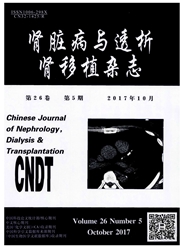

 中文摘要:
中文摘要:
目的:通过分析我院收治的1例肾小球毛细血管内皮病合并甲状腺功能减退患者的诊治过程,结合相关文献,探讨此病的临床特点和诊疗方法。方法:报告北京军区总医院收治的1例肾小球毛细血管内皮病合并甲状腺功能减退病例的其临床资料及诊疗过程,并复习相关文献,对肾小球毛细血管内皮病合并甲状腺功能减退的病因、临床表现、诊断、治疗及预后进行分析,并总结其诊疗经验。结果:1例肾小球毛细血管内皮病合并甲状腺功能减退患者经综合治疗后病情好转出院,出院后继续接受对症治疗,目前患者恢复良好。结论:肾小球毛细血管内皮病的发病率低,合并甲状腺功能减退更少见,其发病原因不明,部分与药物、毒物或者病毒感染有关,多数病例对症治疗后预后较好。
 英文摘要:
英文摘要:
Objective: To study the clinical characteristics and treatment methods of this disease by reporting one case of glomeru- lar capillary endothelial disease patient associated with hypothyroidism and discussing the early diagnosis and treatment of the patient. Methods: One case of glomerular capillary endothelial disease associated with hypothyroidism cases was reported. Clinical data and the treatment process were reported. The literatures were reviewed. The etiology, clinical presentation, diagnosis, treatment and prognosis were analyzed, then the treatment experience was summarized. Results: The patient of glomerular endothelial disease with hypothy- roidism was discharged after combined treatment. She continued to receive symptomatic treatment after discharge and the patient recov- ered well. Conclusions: The incidence of glomerular capillary endothelial disease associated with hypothyroidism is very rare, its etiology is unknown, and some drugs, toxins or viral infection maybe are involved. Major patients prognosis are good after symptomatic treat- ment.
 同期刊论文项目
同期刊论文项目
 同项目期刊论文
同项目期刊论文
 Long-term renal survival and related risk factors in patients with IgA nephropathy: results from a c
Long-term renal survival and related risk factors in patients with IgA nephropathy: results from a c Orticosteroid therapy in IgA nephropathy with minimal change-like lesions: a single-center cohort st
Orticosteroid therapy in IgA nephropathy with minimal change-like lesions: a single-center cohort st MiR-223 down-regulation promotes glomerular endothelial cell activation by up-regulating importin &a
MiR-223 down-regulation promotes glomerular endothelial cell activation by up-regulating importin &a 期刊信息
期刊信息
